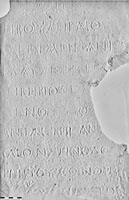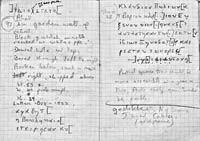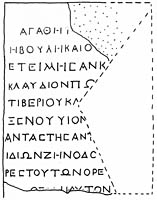1955/97: Ahat (Akmoneia)
- Type of monument:
- Honorific statue-base.
- Location:
- In the wall of the school garden, by the main gate.
- Description:
- Whitish marble block re-used as a water-pipe. Dowel-hole in top, bored through from left to right. Broken below, sunk in concrete right, chipped above.
- Dimensions:
- Ht. 0.53+; W. 0.40; Th. 0.39; letters 0.017-0.022.
- Record:
- Partial squeeze (left hand side only); MB notebook copy; in the text below, italicised letters appear only in MB's copy.
- Publication:
- Thonemann, forthcoming.
- Date:
- c. AD 150-175 (prosopography)
ἀγαθῇ τ̣[ύχῃ]
ἡ βουλὴ καὶ ὁ [δῆμος]
ἐτείμησαν Κυ[ίντον]
Κλαύδιον Πωλίων̣[α]
5Τιβερίου Κλα̣[υδ]ίου Εὐ̣-
ξένου υἱὸν, [τ]ὸ̣ν ἀνδ̣[ρι]-
άντα στησάντ̣[ων] ἐκ τῶ[ν]
ἰδίων Ζηνοδότ̣[ο]υ̣ καὶ [Ὀ]-
ρέστου τῶν Ὀρέσ[του]
10 [. . . c.6 . . .] . . α̣ὐ̣τὸν .[- -]
- - - - - - - - - - - - - - - - - -
With good fortune. The council and the [people] honoured Qu[intus] Claudius Pollio, son of Tiberius Cla[ud]ius Euxenos; the statue was set up from their own funds by Zenodotos and Orestes, the sons of Orestes…
Illustrations:
References:
Campanile, M. D. (1994) I sacerdoti del Koinon d'Asia (I sec. a.C.-III sec. d.C.). Pisa.
Franco, C. (2005) Elio Aristide e Smirne. Rome.
Lambertz, M. (1914) 'Zur Ausbreitung des Supernomen oder Signum im römischen Reiche, II', Glotta 5: 99-170.
Nissen, Th. (1912) S. Abercii Vita. Leipzig.
Thonemann, P. (forthcoming), 'Abercius of Hierapolis. Christianisation and Social Memory in Late Antique Asia Minor', in Creating the Past. Essays... Simon Price, eds. B. Dignas and R. R. R. Smith. Oxford.
- BE
- Bulletin épigraphique, annually in REG.
- BMC
- A Catalogue of the Greek Coins in the British Museum. London, 1873-. Individual volumes identified by region, e.g. BMC Phrygia.
- Coll. Wadd.
- E. Babelon, Inventaire sommaire de la collection Waddington. Paris, 1898.
- GM Winterthur
- Griechische Münzen in Winterthur
- Haspels, Highlands
- C. H. E. Haspels, The Highlands of Phrygia: Sites and Monuments (2 vols.). Princeton, 1971.
- IGR
- R. Cagnat, Inscriptiones Graecae ad res Romanas pertinentes (3 vols.). Paris, 1906-1927.
- Imhoof-Blumer, KM
- F. Imhoof-Blumer, Kleinasiatische Münzen (2 vols.). Vienna, 1901-2.
- MAMA IV
- W. H. Buckler, W. M. Calder and W. K. C. Guthrie, Monumenta Asiae Minoris Antiqua IV: Monuments and Documents from Eastern Asia and Western Galatia. Manchester, 1933.
- MAMA V
- C. W. M. Cox and A. Cameron, Monumenta Asiae Minoris Antiqua V: Monuments from Dorylaeum and Nacolea. Manchester, 1937.
- MAMA VI
- W. H. Buckler and W. M. Calder, Monumenta Asiae Minoris Antiqua VI: Monuments and Documents from Phrygia and Caria. Manchester, 1939.
- Ramsay, Phrygia
- W. M. Ramsay, The Cities and Bishoprics of Phrygia. Oxford, 1895-7. Vol. I. Part I: The Lycus Valley and South-Western Phrygia (1895). Vol. I. Part II: West and West-Central Phrygia (1897). Vol. II (on Northern Phrygia) never appeared; we refer to the two published volumes throughout as I and II.
- SEG
- Supplementum Epigraphicum Graecum
- SNG Von Aulock
- Sylloge Nummorum Graecorum, Sammlung Hans Von Aulock (4 vols.). Berlin, 1957-68.
- TIB Phrygien
- K. Belke and N. Mersich, Tabula Imperii Byzantini 7. Phrygien und Pisidien. Vienna, 1990.





This monument is the base of a statue voted by the boule and demos of Akmoneia and set up at the expense of two brothers, Zenodotos and Orestes, the sons of Orestes. In line 7, one would have expected ἀναστησάντων; it is possible that the mason accidentally omitted the first three letters of the word through haplography (ἀνδριάντα <ἀνα>στησάντων).
The honorand, Q. Claudius Pollio, son of Ti. Claudius Euxenos, is twice attested at the neighbouring city of Hierapolis, in the Phrygian Pentapolis, although this is the first text to give his full name and patronym. His is the sole magistrate's name to appear on the provincial bronze coinage of Hierapolis, in the form 'Claudius Pollio, asiarch'. Pollio minted five different issues at Hierapolis, with obverse types depicting Marcus Aurelius, Lucius Verus, Faustina ΙΙ, Herakles, and the personified demos of Hierapolis. The types for Marcus and Verus (nos. 1-2) carry the reverse legend ἐπιμεληθέντος Κλ. Πωλλίωνος ἀσιάρχου Ἱεροπολειτῶν; the other types (nos. 3-5) have an abbreviated version.
(1) M. Aurelius/Zeus: SNG Von Aulock 8386
(2) L. Verus/Zeus: BMC Phrygia 267, no. 14; Imhoof-Blumer, KM I 244, no. 4
(3) Faustina II/Cybele: BMC Phrygia 268, no. 15; BM 1921-4-12-96; Coll. Wadd. 6189; KM I 244, no. 3
(4) Herakles/bucranium with crescent moon and stars: BMC Phrygia 265, no. 1; Coll. Wadd. 6186; KM I 244, 1; Münzen u. Medaillen Deutschland Auction 16 (2005) 515
(5) Demos/Men: BMC Phrygia 265, no. 4; Coll. Wadd. 6187; KM I 244, no. 2
We may assume that all five types were minted on the same occasion, presumably that of Pollio's asiarchate, which thus ought to fall between AD 161 and 169 (Campanile 1994: 90). That his asiarchate is not mentioned on our inscription from Akmoneia may, but not need, imply that the inscription predates the coin-issues.
Pollio also appears in a hagiographical text of the late fourth or early fifth century, the Life of Abercius, the fictionalised biography of a second-century bishop of Hierapolis (Nissen 1912: 3-55; Thonemann, forthcoming). The historical setting of the Life of Abercius is the period of the joint reign of Marcus Aurelius and Lucius Verus. One of the leading characters in the Life is a certain Euxeinianos Pollio, there described as 'the greatest man in the city [sc. Hierapolis], and possessing great influence, since he was respected and highly honoured by the emperor' (Εὐξεινιανοῦ τοῦ Πολλίωνος τοῦ μεγίστου ὄντος ἐν τῇ πόλει καὶ δυναστεύοντος ὡς παρὰ τοῦ αὐτοκράτορος γνωρίμου καὶ τιμιωτάτου ὄντος: Vita Abercii 20). All three individuals – Q. Claudius Pollio, son of Ti. Claudius Euxenos (inscription from Akmoneia); Claudius Pollio, asiarch (coinage from Hierapolis); Hieropolitan magnate Euxeinianos Pollio (Life of Abercius) – are evidently to be identified with one another (Franco 2005: 500-3; Thonemann, forthcoming).
The form Euxeinianos in the Life of Abercius is simply a patronymic adjective or signum representing 'son of Euxe(i)nos'. This onomastic phenomenon is fairly common in Roman Asia Minor (Lambertz 1914: 149-51). A near-contemporary of Pollio at Apameia-Kelainai, in southern Phrygia, carried the name Τιβέριος Κλαύδιος Τιβερίου Κλαυδίου Μιθριδάτου υἱὸς Κυρείνα Πείσων Μιθριδατιανός ('Ti. Claudius Piso, son of Ti. Claudius Mithridates, of the tribe Quirina, also known as Mithridatianos': MAMA VI 180; IGR IV 790); also at Apameia, in the late third century AD, we hear of an individual by the name of Μ. Αὐρ. Ἀντώνιος Τ[ρυφωνιαν]ὸς Ἀπολλινάριος, son of [Πρ]οκλιανὸς Τρύφων (IGR IV 784). It is not difficult to assume that Q. Claudius Pollio, son of Ti. Claudius Euxenos, was also commonly known as Euxe(i)nianos.
The name Euxenos is not especially common; it was, however, current in central Phrygia during the Roman imperial period. A native of Eukarpia, also in the Pentapolis, carried the name Πατροκλῆς Πατροκλέους τοῦ Εὐξένο[υ π]ένπτου Εὐκαρπεύς (MAMA XI 1954/13 [SEG 15, 810]: Emircik, territory of Eumeneia). The name is twice attested at Eumeneia (Ramsay, Phrygia II 389, no. 239: Haydan, territory of Eumeneia; MAMA IV 346: Işıklı). At Sebaste, we find a Euxenos son of Apollonios (Ramsay, Phrygia II 600, no. 472: Selçikler). At Akmoneia itself, a woman by the name of Euxenis is known (MAMA VI 301: Ahat), and an inscription from Hocalar, south-east of Ahat (territory of Diokleia?), records the name of a woman called Basilo, daughter of Euxenos (MAMA VI 358). Further to the north, in the highlands north of Afyon, we find a Demas son of Euxenos (Haspels, Highlands 353, no. 141: Ilıca), and at Nakoleia, a Euxenides (MAMA V 272: Seyitgazi).
The spelling of the name Pollio in this text is paralleled in another inscription from Akmoneia (MAMA XI 1955/99: Πωλ̣ί̣ων̣[α]) and in a text from Brouzos in the Pentapolis (MAMA XI 1955/38 [IGR IV 681]: Πωλίωνος, gen.). The coinage from Hierapolis has the more accurate spelling Πωλλίωνος (gen.).